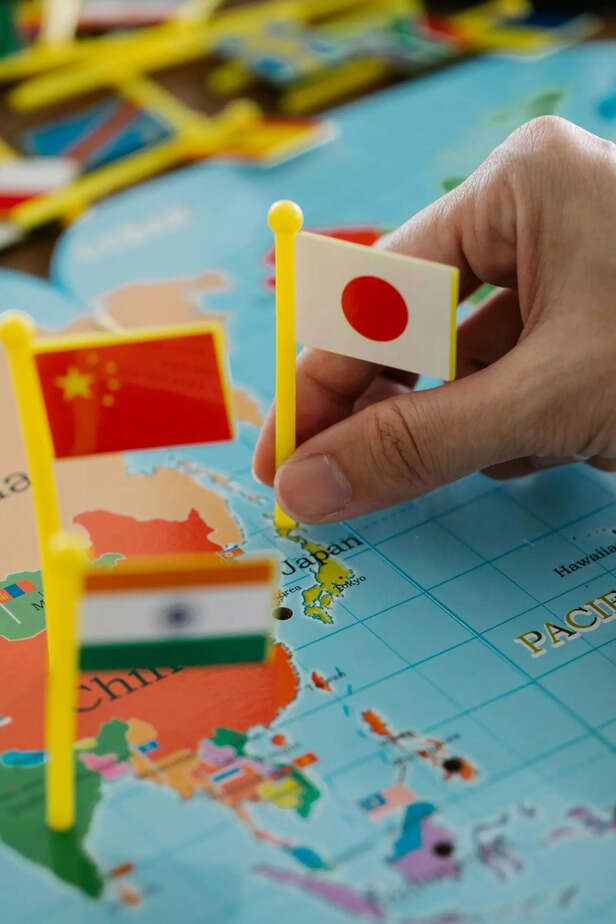Why Apple Is Doubling Down on India Even as US Trade Wars Escalate!
Ankita Rai | Fri, 30 May 2025
Apple is shifting its focus to India amid escalating US-China trade tensions and potential tariffs on Chinese made goods. Making iPhones in India costs significantly less than in the US, and Apple’s partners have expanded local manufacturing, including parts production. Beyond assembly, Apple is growing its retail presence to tap into India’s rising premium smartphone market. This move also helps Apple diversify supply risks exposed during the pandemic. While challenges remain, Apple’s long-term bet on India is clear: it’s not just a backup plan but a key hub for manufacturing, sales, and growth in the coming decade.
( Image credit : ANI )
Photo:
As global tensions escalate and trade wars loom—particularly between China and the United States, Apple finds itself at a critical juncture. With former President Donald Trump floating the idea of a 25% import tariff on Chinese-assembled products, companies like Apple are under increasing pressure to rethink their global supply chains. Rather than retreating, Apple is doubling down—and India is emerging as the centerpiece of this pivot. India is no longer just a backup option. It’s shaping up to be Apple’s next big production and consumer base.
The Trouble with China

Apple’s long-standing relationship with China has delivered tremendous scale, efficiency, and expertise. But rising geopolitical friction, especially with the US, has turned those strengths into potential liabilities. If the proposed 25% tariff on Chinese-made electronics is enacted, Apple could face over $200 in added costs per iPhone in the US market. That’s a price point Apple is unlikely to absorb—or pass on to cost-sensitive customers.
Why India Works

India offers a compelling combination of affordability and long-term strategic value. Apple can produce an iPhone in India for approximately $912, compared to nearly $2,900 in the United States. That’s not just a cost-saving it’s a calculated business win.
Major suppliers like Foxconn, Pegatron, and Wistron have already expanded operations in India. Under the Indian government’s Production-Linked Incentive (PLI) scheme, not only are iPhones being assembled, but component manufacturing is also on the rise.
By 2023, around 14% of all iPhones were made in India. That share is expected to rise steadily as Apple deepens its roots in the region.
Not Just Making iPhones, Selling Them Too

Apple’s India strategy isn’t limited to manufacturing. In 2023, it launched its first two official retail stores in Mumbai and Delhi marking a significant expansion of its physical presence. While the majority of Indian smartphone users still opt for affordable Android models, a growing segment of upwardly mobile consumers is willing to pay a premium for Apple products. With a large youth demographic, surging internet penetration, and rising disposable incomes, India is expected to become the world’s largest smartphone market by 2026. Apple is positioning itself as the brand of choice in this emerging premium segment. India is no longer just an assembly line it is a future market powerhouse for Apple.
Spreading Out the Risk

Apple’s move to India also serves as a form of risk management. COVID-19 lockdowns in China disrupted iPhone production, exposing the vulnerabilities of relying too heavily on a single country. Apple took that lesson seriously. India, with its stable democracy, young workforce, and infrastructure improvements, is becoming an attractive alternative. Supported by initiatives like the Delhi-Mumbai Industrial Corridor and enhanced logistics networks, the country is gearing up to host large-scale global operations. India’s geopolitical neutrality in the US-China standoff also makes it an ideal partner for companies seeking diversification.
Beating the Tariff Trap

Here’s where things get even more strategic. If the proposed US tariffs on China-made products come into effect, Apple can shield itself by exporting Indian-made iPhones to major global markets. This shift is already underway. India-manufactured iPhones are now shipped to over 30 countries, including the US, UK, and EU. Apple is no longer dependent on China to meet global demand. Instead, India is becoming a pivotal hub in Apple’s international supply chain—one resilient enough to withstand trade wars and political shocks.
Still a Work in Progress

Despite the momentum, Apple’s expansion in India faces hurdles. The electronics supply chain is still developing and lacks the scale and speed of China’s. Infrastructure bottlenecks and policy shifts can slow progress and create uncertainties. Nonetheless, Apple remains committed. It’s investing in everything from employee training to component sourcing and logistics. The goal isn’t just to tap into existing capacity but to actively build India’s electronics manufacturing ecosystem from the ground up.
More Than Just a Backup Plan

This isn’t a short-term fix. Apple’s India strategy is a long-term vision. Western markets are saturated, and Apple’s growth in China faces domestic competition and political hurdles. India, on the other hand, presents the kind of growth potential that tech giants dream of.
Beyond smartphones, Apple is gradually rolling out its wider ecosystem of services, wearables, and digital content in India cultivating a loyal user base from the ground up.
The Big Picture

Apple’s aggressive expansion in India marks a critical evolution in its global strategy. Amid economic uncertainties and growing protectionism, India offers stability, scale, and market potential. Apple isn’t just dodging tariffs or reducing costs, it’s future-proofing its business. By betting big on India, Apple is adapting to a world where trade boundaries are hardening. This shift might just redefine how the global tech economy operates and Apple is leading the way.
Unlock insightful tips and inspiration on personal growth, productivity, and well-being. Stay motivated and updated with the latest at My Life XP.
The Trouble with China

China
( Image credit : Pexels )
Apple’s long-standing relationship with China has delivered tremendous scale, efficiency, and expertise. But rising geopolitical friction, especially with the US, has turned those strengths into potential liabilities. If the proposed 25% tariff on Chinese-made electronics is enacted, Apple could face over $200 in added costs per iPhone in the US market. That’s a price point Apple is unlikely to absorb—or pass on to cost-sensitive customers.
Why India Works

Why is Apple choosing India?
( Image credit : Pexels )
India offers a compelling combination of affordability and long-term strategic value. Apple can produce an iPhone in India for approximately $912, compared to nearly $2,900 in the United States. That’s not just a cost-saving it’s a calculated business win.
Major suppliers like Foxconn, Pegatron, and Wistron have already expanded operations in India. Under the Indian government’s Production-Linked Incentive (PLI) scheme, not only are iPhones being assembled, but component manufacturing is also on the rise.
By 2023, around 14% of all iPhones were made in India. That share is expected to rise steadily as Apple deepens its roots in the region.
Not Just Making iPhones, Selling Them Too

iPhone
( Image credit : Pexels )
Apple’s India strategy isn’t limited to manufacturing. In 2023, it launched its first two official retail stores in Mumbai and Delhi marking a significant expansion of its physical presence. While the majority of Indian smartphone users still opt for affordable Android models, a growing segment of upwardly mobile consumers is willing to pay a premium for Apple products. With a large youth demographic, surging internet penetration, and rising disposable incomes, India is expected to become the world’s largest smartphone market by 2026. Apple is positioning itself as the brand of choice in this emerging premium segment. India is no longer just an assembly line it is a future market powerhouse for Apple.
Spreading Out the Risk

Apple
( Image credit : Pexels )
Apple’s move to India also serves as a form of risk management. COVID-19 lockdowns in China disrupted iPhone production, exposing the vulnerabilities of relying too heavily on a single country. Apple took that lesson seriously. India, with its stable democracy, young workforce, and infrastructure improvements, is becoming an attractive alternative. Supported by initiatives like the Delhi-Mumbai Industrial Corridor and enhanced logistics networks, the country is gearing up to host large-scale global operations. India’s geopolitical neutrality in the US-China standoff also makes it an ideal partner for companies seeking diversification.
Beating the Tariff Trap

iPhone
( Image credit : Pexels )
Here’s where things get even more strategic. If the proposed US tariffs on China-made products come into effect, Apple can shield itself by exporting Indian-made iPhones to major global markets. This shift is already underway. India-manufactured iPhones are now shipped to over 30 countries, including the US, UK, and EU. Apple is no longer dependent on China to meet global demand. Instead, India is becoming a pivotal hub in Apple’s international supply chain—one resilient enough to withstand trade wars and political shocks.
Still a Work in Progress

Mac
Despite the momentum, Apple’s expansion in India faces hurdles. The electronics supply chain is still developing and lacks the scale and speed of China’s. Infrastructure bottlenecks and policy shifts can slow progress and create uncertainties. Nonetheless, Apple remains committed. It’s investing in everything from employee training to component sourcing and logistics. The goal isn’t just to tap into existing capacity but to actively build India’s electronics manufacturing ecosystem from the ground up.
More Than Just a Backup Plan

iPhone
( Image credit : Pexels )
This isn’t a short-term fix. Apple’s India strategy is a long-term vision. Western markets are saturated, and Apple’s growth in China faces domestic competition and political hurdles. India, on the other hand, presents the kind of growth potential that tech giants dream of.
Beyond smartphones, Apple is gradually rolling out its wider ecosystem of services, wearables, and digital content in India cultivating a loyal user base from the ground up.
The Big Picture

What is the next big plan?
( Image credit : Pexels )
Apple’s aggressive expansion in India marks a critical evolution in its global strategy. Amid economic uncertainties and growing protectionism, India offers stability, scale, and market potential. Apple isn’t just dodging tariffs or reducing costs, it’s future-proofing its business. By betting big on India, Apple is adapting to a world where trade boundaries are hardening. This shift might just redefine how the global tech economy operates and Apple is leading the way.
Unlock insightful tips and inspiration on personal growth, productivity, and well-being. Stay motivated and updated with the latest at My Life XP.
Frequently Asked Questions (FAQs)
- Why is Apple expanding manufacturing in India?To reduce costs, avoid tariffs, and diversify its supply chain amid US-China trade tensions.
- How much does it cost to make an iPhone in India compared to the US?About $900 in India versus nearly $3,000 in the US.
- Is Apple only manufacturing in India or also selling there?Apple is both manufacturing and expanding its retail presence to grow sales in India.









